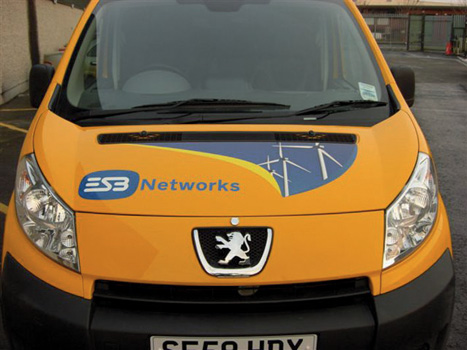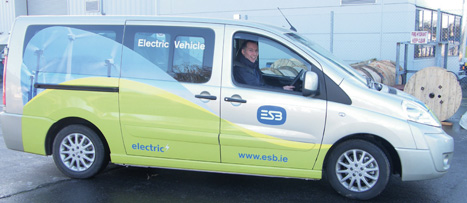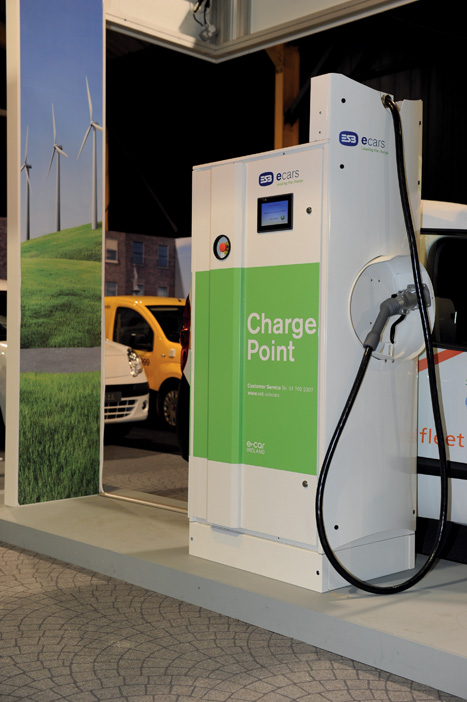With the announcement of the Source London scheme last week, aiming to install 1,300 public charging points across the city by 2013, mayor Boris Johnson employed his usual love of hyperbole. The scheme, he said, would make London ’the electric car capital of Europe’. But, despite the ambition of Source London, he might have to concede the title to the capital city to the west: Dublin.
The Republic of Ireland is in the midst of a plan to spread electric vehicle (EV) charging points all over the country. Aiming to make Ireland the first country in Europe with a charging infrastructure that is truly accessible to anyone, anywhere, the E-Car Ireland scheme is an integral part of the government’s plan for a tenth of all cars to be electric powered by 2020 a goal that would mean that 250,000 EVs need to be on the road in the next nine years.

Ireland is an ideal location for EVs, explained Senan McGrath, chief technology officer of ESB Cars, the subsidiary of the Irish Electricity Supply Board (ESB), which is co-ordinating the project. ’There’s a single company running the entire electricity network, so there are no problems with compatibility of different systems,’ he told a recent conference on green transport in Dublin. The country is small, he added, which naturally limits the range that vehicles travel in single journeys. Most dwellings are single family rather than split into flats, which eases problems with parking for charging. The small population of Ireland six million people, of whom a third live in or around Dublin also works in the country’s favour. ’Moreover,’ said McGrath, ’we have an ideal climate for batteries summers aren’t too hot, winters aren’t too cold and batteries don’t care if it’s raining.’
Another factor is the high proportion of wind power in Ireland’s electricity mix, he added. The peak system demand in the republic is about 5,000MW. Currently, the country has 1,459MW of installed wind capacity; this will double by next year, with capacity that is currently planned or under construction coming online. By 2020, it is expected to reach 6,000MW, meaning that Ireland will be a net exporter of wind power.
Charging the cars by wind solves one of the main objections to EVs – that they don’t solve, but merely shift, emissions problems
But wind can blow at any time, McGrath pointed out. ’The night-time demand is about 1,600MW, so we could find ourselves with a lot of power being generated when at the moment, at least there’s no demand for it,’ he said. ’Trials of EVs show that most people charge them at home, at night, when rates are off peak; that’s a good match for the projected generation profile.’ Charging the cars by wind also solves one of the main objections to electric vehicles that they don’t solve emissions problems, they merely shift them to an often fossil-fuel-burning point source.

The scheme is aiming to install 1,500 public charging points by the end of 2011: 500 in and around Dublin; 135 in Cork; and 45 each in Limerick, Galway and Waterford. There will be at least one public charging point for every town with a population of more than 1,500. In addition, there will be 2,000 home chargers (although the number is dependent on EV sales) and 30 or more DC fast chargers. Three different charger types will be installed, McGrath said: the home chargers will be able to fully charge a car in six to eight hours, aimed at overnight use; the public chargers in supermarket and other car parks, which will charge in two to eight hours, and the DC fast chargers, at service stations along the main routes linking cities, which will charge a car from ’empty’ to 80 per cent of total charge in 20 minutes.
ESB E-Cars has recently signed an agreement with three service-station operators to install these fast chargers, using electronic AC/DC conversion to a Japanese standard called Chademo. ’The availability of fast-charge points will help to reassure drivers that longer journeys between urban centres are practical and that Ireland is well on the way to making E-Car driving a reality,’ said ESB chief executive, Padraig McManus.
“Here, summers aren’t too hot, winters aren’t too cold and batteries don’t care if it’s raining”
SENAN MCGRATH, ESB CARS
In addition, the government is ensuring that E-Cars will be easy to get hold of, with memoranda of understanding with Renault-Nissan and Mitsubishi to supply electric models to the Irish market; McGrath said that brands such as Peugeot, BMW, Opel and Ford could be available from 2012. There is also a system of incentives: a €5,000 (£4,400) grant towards purchase, zero vehicle registration tax and a discounted rate of road tax, along with an accelerated capital allowance scheme for businesses.
McGrath conceded that the integration of EVs into the generating infrastructure, let alone into the lives of users, is a challenge. ESB E-Cars is working with Intel on the grid integration, with its particular bias towards wind power, and on data analysis and charging algorithms to suit how the cars are used by individuals, households and communities. Other IT issues include the control system and interface for the charging points themselves, and customer payment systems, which could include pre-payment, post-payment and anonymous payment cards. ’All of these standards require a national/international integrated approach,’ McGrath said.

Despite the difficulties, however, Ireland’s scheme has a clear goal to make it as easy to own and run an electric car as a conventional petrol or diesel model. With Nissan’s first sale of its Leaf model in Europe to an Irish customer, the show is definitely on the road.
indepth
capital idea
Source London has been created to provide electric vehicle charging points across the city
The Source London scheme is being developed in partnership with Siemens to provide a network of charging points across the capital. With half of its funding from the government’s Plugged-in Places scheme and the remainder from a Transport for London-led consortium, the scheme aims to install 1,300 charging points by 2013, with a pilot scheme in the Royal Docks in East London to open next spring.
According to Boris Johnson, the scheme is, like Ireland’s, aimed at making sure that electric vehicles are easy to use within the city. ’I want to rapidly accelerate the uptake of electric vehicles and make London the “electric vehicle capital of Europe”,’ he said. ’Through Source London, we want to give drivers the confidence to plug into this fantastic technology.’
The scheme will allow any vehicle that is licensed with the DVLA as a pure electric or plug-in hybrid to use any of the Source London charge points for an annual flat rate of £100, which will include the cost of electricity. Electric vehicles will, as now, be exempt from the congestion charge.
Siemens is providing the charging posts, along with the IT systems to operate Source London. This will be based around a secure web portal for members, which will allow them to register, manage their account and pay online. Siemens will also run a UK-based 24-hour call centre for technical issues.
The company is deeply involved with electric vehicle technology, being the co-ordinator of the EU Green eMotion project, a €24m (£21m) drive to develop a European standard approach to e-vehicles. ’Source London has the potential to radically change the transport landscape for the capital,’ said Siemens chief executive Andreas Goss. Head of electric vehicle infrastructure Ralph Griewing said: ’We expect the scheme to be a model for other European electric vehicle charging schemes.’




Swiss geoengineering start-up targets methane removal
No mention whatsoever about the effect of increased methane levels/iron chloride in the ocean on the pH and chemical properties of the ocean - are we...